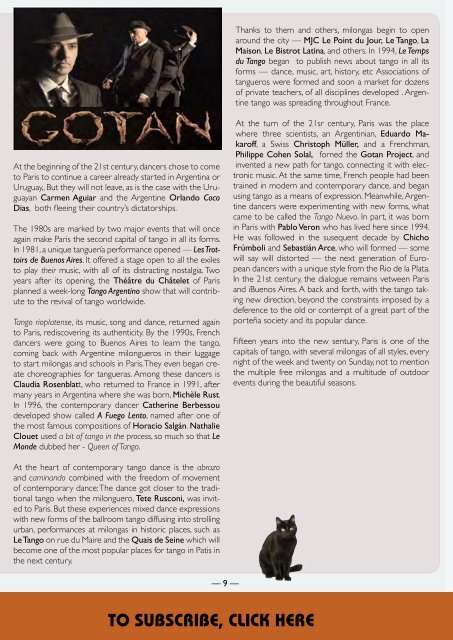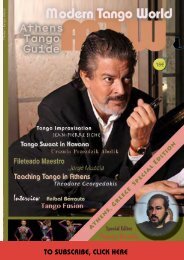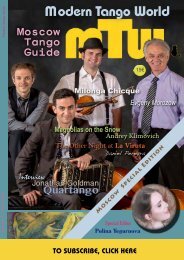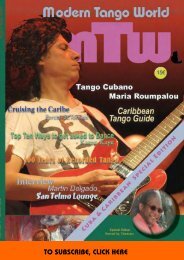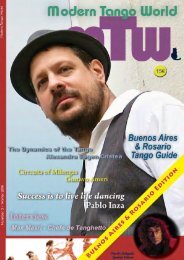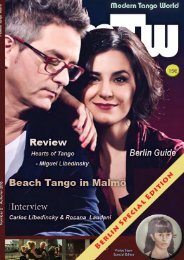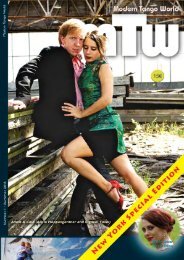Modern Tango World #11 (Paris, France)
Paris Special Features A Century of Parisien Tango Gwen-Haël Denigot 03 Alternative Tango in Paris Yannik Lhermitte 08 Outdoor Tango in Paris Emile Gayoso 13 Guide to Tango in France 18 Tango Portraiture Fabian Perez 28 Pablo Montanelli & Vito Venturino (El Cachivache) Ray Lauzzana 32 Dreaming of Buenos Aires in Moscow Anastasia Pomogaeva 35 Tango Beats in Ecuador Raymond Lauzzana 37 Tango Endings by Steve Darmo Alexandru Eugen Cristea 38 Our Advertisers 41 New Tango Music Arndt Büssing 42 Tango Moves: Boleo/Latigazo Raymond Lauzzana 44 Letters to the Editor 47
Paris Special Features
A Century of Parisien Tango Gwen-Haël Denigot 03
Alternative Tango in Paris Yannik Lhermitte 08
Outdoor Tango in Paris Emile Gayoso 13
Guide to Tango in France 18
Tango Portraiture Fabian Perez 28
Pablo Montanelli & Vito Venturino (El Cachivache) Ray Lauzzana 32
Dreaming of Buenos Aires in Moscow Anastasia Pomogaeva 35
Tango Beats in Ecuador Raymond Lauzzana 37
Tango Endings by Steve Darmo Alexandru Eugen Cristea 38
Our Advertisers 41
New Tango Music Arndt Büssing 42
Tango Moves: Boleo/Latigazo Raymond Lauzzana 44
Letters to the Editor 47
You also want an ePaper? Increase the reach of your titles
YUMPU automatically turns print PDFs into web optimized ePapers that Google loves.
Thanks to them and others, milongas begin to open<br />
around the city — MJC Le Point du Jour, Le <strong>Tango</strong>, La<br />
Maison, Le Bistrot Latina, and others. In 1994, Le Temps<br />
du <strong>Tango</strong> began to publish news about tango in all its<br />
forms — dance, music, art, history, etc Associations of<br />
tangueros were formed and soon a market for dozens<br />
of private teachers, of all disciplines developed . Argentine<br />
tango was spreading throughout <strong>France</strong>.<br />
At the beginning of the 21st century, dancers chose to come<br />
to <strong>Paris</strong> to continue a career already started in Argentina or<br />
Uruguay,. But they will not leave, as is the case with the Uruguayan<br />
Carmen Aguiar and the Argentine Orlando Coco<br />
Dias, both fleeing their country’s dictatorships.<br />
The 1980s are marked by two major events that will once<br />
again make <strong>Paris</strong> the second capital of tango in all its forms.<br />
In 1981, a unique tanguería performance opened — Les Trottoirs<br />
de Buenos Aires. It offered a stage open to all the exiles<br />
to play their music, with all of its distracting nostalgia. Two<br />
years after its opening, the Théâtre du Châtelet of <strong>Paris</strong><br />
planned a week-long <strong>Tango</strong> Argentino show that will contribute<br />
to the revival of tango worldwide.<br />
<strong>Tango</strong> rioplatense, its music, song and dance, returned again<br />
to <strong>Paris</strong>, rediscovering its authenticity. By the 1990s, French<br />
dancers were going to Buenos Aires to learn the tango,<br />
coming back with Argentine milongueros in their luggage<br />
to start milongas and schools in <strong>Paris</strong>. They even began create<br />
choreographies for tangueras. Among these dancers is<br />
Claudia Rosenblatt, who returned to <strong>France</strong> in 1991, after<br />
many years in Argentina where she was born, Michèle Rust.<br />
In 1996, the contemporary dancer Catherine Berbessou<br />
developed show called A Fuego Lento, named after one of<br />
the most famous compositions of Horacio Salgán. Nathalie<br />
Clouet used a bit of tango in the process, so much so that Le<br />
Monde dubbed her - Queen of <strong>Tango</strong>.<br />
At the turn of the 21sr century, <strong>Paris</strong> was the place<br />
where three scientists, an Argentinian, Eduardo Makaroff,<br />
a Swiss Christoph Müller, and a Frenchman,<br />
Philippe Cohen Solal, forned the Gotan Project, and<br />
invented a new path for tango. connecting it with electronic<br />
music. At the same time, French people had been<br />
trained in modern and contemporary dance, and began<br />
using tango as a means of expression. Meanwhile, Argentine<br />
dancers were experimenting with new forms, what<br />
came to be called the <strong>Tango</strong> Nuevo. In part, it was born<br />
in <strong>Paris</strong> with Pablo Veron who has lived here since 1994.<br />
He was followed in the susequent decade by Chicho<br />
Frúmboli and Sebastián Arce, who will formed — some<br />
will say will distorted — the next generation of European<br />
dancers with a unique style from the Rio de la Plata.<br />
In the 21st century, the dialogue remains vetween <strong>Paris</strong><br />
and iBuenos Aires. A back and forth, with the tango taking<br />
new direction, beyond the constraints imposed by a<br />
deference to the old or contempt of a great part of the<br />
porteña society and its popular dance.<br />
Fifteen years into the new sentury, <strong>Paris</strong> is one of the<br />
capitals of tango, with several milongas of all styles, every<br />
night of the week and twenty on Sunday, not to mention<br />
the multiple free milongas and a multitude of outdoor<br />
events during the beautiful seasons.<br />
At the heart of contemporary tango dance is the abrazo<br />
and caminando combined with the freedom of movement<br />
of contemporary dance: The dance got closer to the traditional<br />
tango when the milonguero, Tete Rusconi, was invited<br />
to <strong>Paris</strong>. But these experiences mixed dance expressions<br />
with new forms of the ballroom tango diffusing into strolling<br />
urban, performances at milongas in historic places, such as<br />
Le <strong>Tango</strong> on rue du Maire and the Quais de Seine which will<br />
become one of the most popular places for tango in Patis in<br />
the next century.<br />
— 9 —<br />
TO SUBSCRIBE, CLICK HERE


